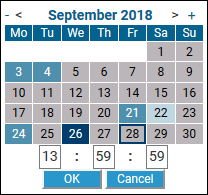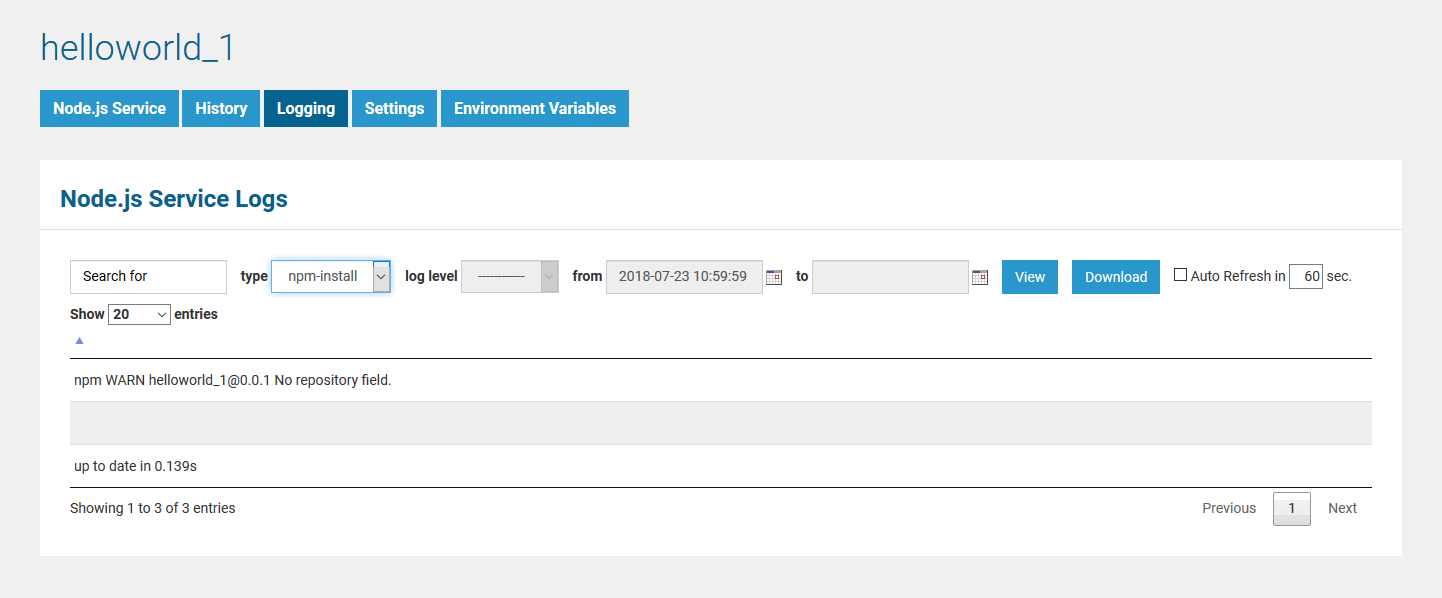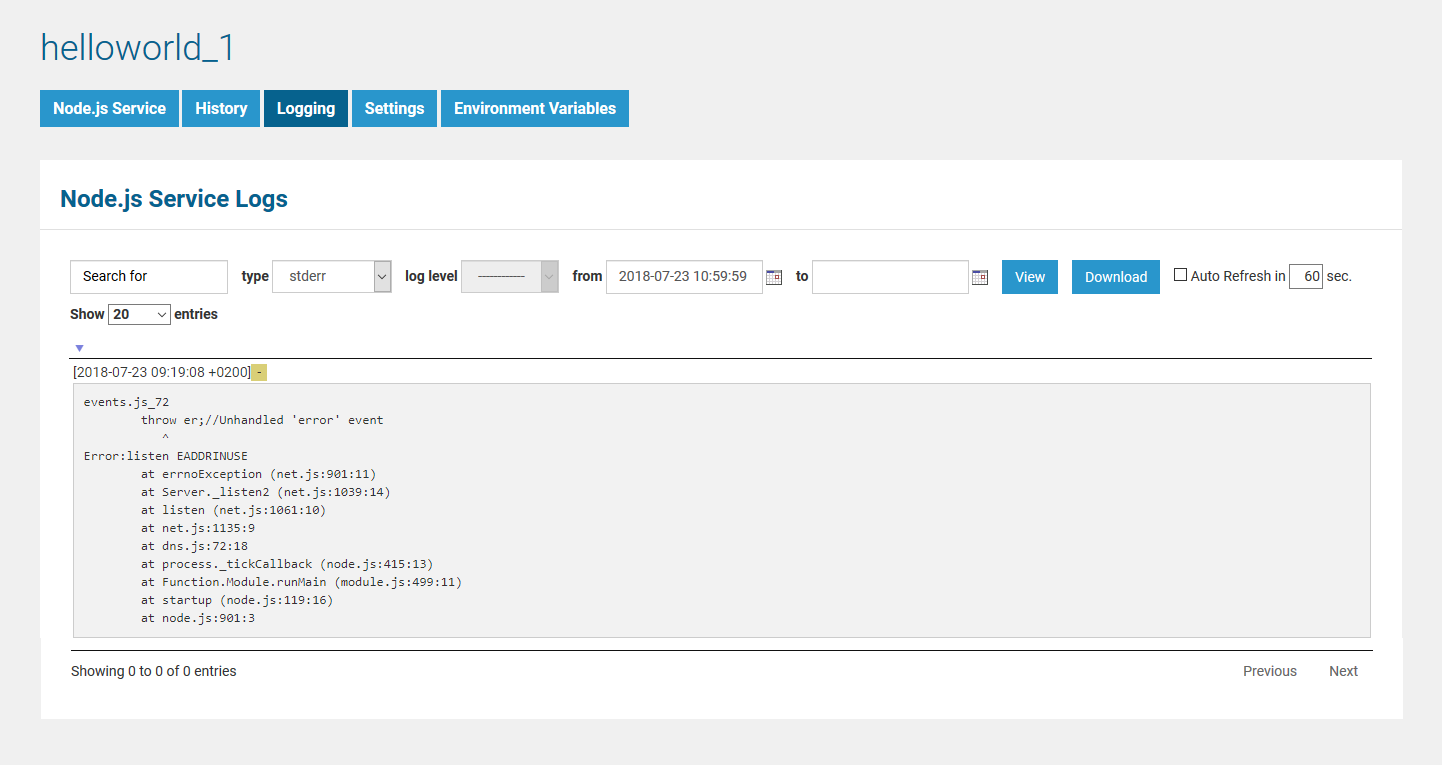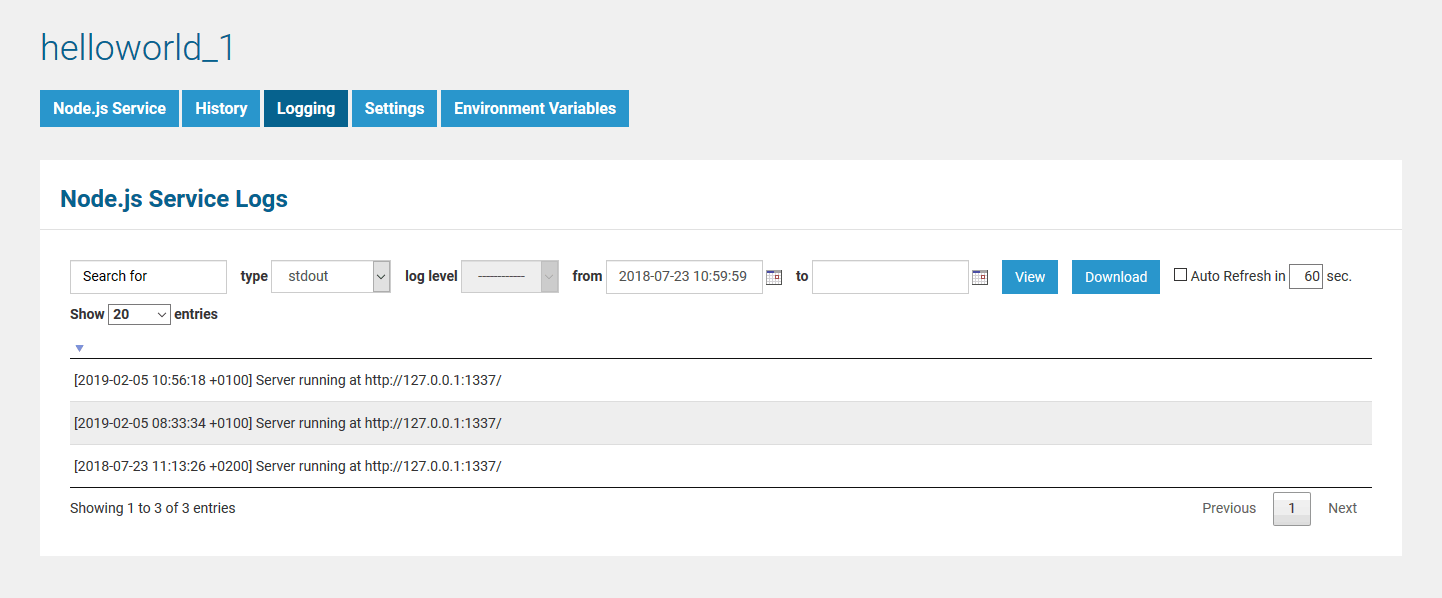- Created by Kirstin Seidel-Gebert, last modified by Annegret Bernhardt on Jan 26, 2024
You can only inspect the details of Node.js services of the node instance the used Bridge is running on. If you have aggregated multiple node instances into a Bridge domain, you need to use the Bridge of the specific node instance the Node.js service is running on.
Switch to the Logging tab in the information/working area.
All users have access to logged information that is categorized as follows:
| Log | Technical Name | Description | ||||||||||||||||||||
|---|---|---|---|---|---|---|---|---|---|---|---|---|---|---|---|---|---|---|---|---|---|---|
| Installation Log | npm-install | Contains errors and warnings that have been written during npm install. | ||||||||||||||||||||
| Start Log | start | Contains information about the selected Node.js service, environment variables, and errors logged by the Bridge process at startup. | ||||||||||||||||||||
| Error Log | stderr | Contains errors that have been written by the Node.js service to stderr. | ||||||||||||||||||||
| Service Log | stdout | Contains messages that have been written by the Node.js service to stdout. | ||||||||||||||||||||
| Custom Logs | <your name> | The Bridge can also display custom logfiles. To be able to access this custom logfiles via the Bridge, they must meet the following conditions:
| ||||||||||||||||||||
Filtering the Log Entries
Logs may contain big amounts of data and in these cases it may be difficult to find the peace of information you are looking for. Therefore, you can filter the logfile entries by a regular expression, and - depending on the log type - by log level and date/time.
| Filter Element | Description | Default |
|---|---|---|
| Search for | Insert a string or a valid regular expression to search the log entries for. Only log entries that match the expression will be displayed. Pressing Enter in this field triggers the search. | empty |
| type | Select the type of logfile you want to display: npm-install, start, stderr, stdout, custom log types. See top of this page for more information on the log types. The log types are displayed in this list in alphabetical order and the first log type of this list will be the default. So, if you added a custom log named aa.log, this log will be displayed on going to the Logging page. | first available log type |
| log level | This filter is not available for Node.js services. | |
| from | Select the date/time range you want to inspect.
Pressing Enter in these fields triggers the search. To enter the dates, you can use a date picker next to the input fields: This filter is available only for the error log, service log and for custom logs, if they feature timestamps. The timestamp must follow one of the following patterns:
It is allowed to put the timestamp in square brackets. | actual timestamp - 10 min |
| to | empty |
Click View to update the displayed logging information. The date filter settings will be kept as long as your Browser tab is open. They will be reset to default as soon as you open the Logging tab in a new Browser tab. If you close your Browser with the Logging tab open, and start your Browser again with restoring all recent tabs (session restore), your date filter settings will be reloaded from your previous search.
As per default, for logs with a time stamp the log entries are displayed latest first in the search results. Click the tiny arrow in the table header to change the order to oldest first.
The Date Picker
When filtering the log entries of a service by date and time, you can use a date picker to select a date from/to. Click the date picker icon The time part will be only visible if the related log entries contain a time part in format "HH:MM:SS". In all other cases, it is not possible to select log entries by time. Some dates within the calendar are colored to help you finding the appropriate date: Select a day, enter a time (if necessary), and click OK to apply the selected date to the search field.![]() next to the input fields to open the a tiny calendar to pick the dates from.
next to the input fields to open the a tiny calendar to pick the dates from.
Color Meaning dark blue border Today. dark blue The selected date. bright blue A weekday on which data has been logged. light blue A weekend day on which data has been logged. grey A day on which no data has been logged.
The Search Results
The results according to your search conditions are displayed in a paged list:
- You can define how many results should be displayed on one page by selecting on of 20, 50, 100, 250 and 1000 from the Show entries dropdown.
- At the bottom of the log table, you can see how many log entries have been found and how many of them are displayed: Showing 1 to 20 of 78 entries.
- You can auto refresh the search results by checking the Auto Refresh checkbox. Specify an interval in seconds, or leave the default (60 seconds).
- Multi-line log messages are collapsed to not clutter the list of results. You can expand those multipart lines by clicking the plus sign at the end of the visible message part.
- Use the buttons Previous and Next to browse through the results, or select a result page by clicking on a page number.
- By clicking Download, you can download the search result (all pages) as a simple flat file that resides in a ZIP archive.
Installation Log
The npm-install log contains the output of the npm install command.
Select npm-install from the Type drop-down list to view the installation log. You cannot select a date range, as the npm-install log will be overwritten each time the command is executed.
Figure: The Node.js Service npm-install Log

Start Log
Select start from the Type drop-down list. Selecting a date has no effect, as the start log will be overwritten each time the Node.js service is started.
The start log contains the following information:
- information on the environment variables used (see also Setting Environment Variables for Node.js Services)
- information on the selected service
- service name and version
- working directory of the service
- start script
- errors that occurred during startup
Figure: The Node.js Service Start Log

Error Log
Select stderr from the Type drop-down list and filter the log by date, if necessary.
The error log contains errors that have been written by the Node.js service to stderr.
Figure: The Node.js Service Error Log

Service Log
Select stdout from the Type drop-down list.
The service log contains messages that have been written by the Node.js service to stdout.
Figure: The Node.js Service Log

Log Encoding
If you are writing messages to log files that will be displayed on the Bridge (npm-install, start, stdout, stderr, custom logfiles), you must use UTF-8 encoding. If you do not, special characters may be displayed wrongly in the log view.
- No labels